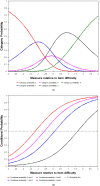ReHabgame: A non-immersive virtual reality rehabilitation system with applications in neuroscience
- PMID: 29560446
- PMCID: PMC5857620
- DOI: 10.1016/j.heliyon.2018.e00526
ReHabgame: A non-immersive virtual reality rehabilitation system with applications in neuroscience
Abstract
This paper proposes the use of a non-immersive virtual reality rehabilitation system "ReHabgame" developed using Microsoft Kinect™ and the Thalmic™ Labs Myo gesture control armband. The ReHabgame was developed based on two third-person video games that provide a feasible possibility of assessing postural control and functional reach tests. It accurately quantifies specific postural control mechanisms including timed standing balance, functional reach tests using real-time anatomical landmark orientation, joint velocity, and acceleration while end trajectories were calculated using an inverse kinematics algorithm. The game was designed to help patients with neurological impairment to be subjected to physiotherapy activity and practice postures of daily activities. The subjective experience of the ReHabgame was studied through the development of an Engagement Questionnaire (EQ) for qualitative, quantitative and Rasch model. The Monte-Carlo Tree Search (MCTS) and Random object (ROG) generator algorithms were used to adapt the physical and gameplay intensity in the ReHabgame based on the Motor Assessment Scale (MAS) and Hierarchical Scoring System (HSS). Rasch analysis was conducted to assess the psychometric characteristics of the ReHabgame and to identify if these are any misfitting items in the game. Rasch rating scale model (RSM) was used to assess the engagement of players in the ReHabgame and evaluate the effectiveness and attractiveness of the game. The results showed that the scales assessing the rehabilitation process met Rasch expectations of reliability, and unidimensionality. Infit and outfit mean squares values are in the range of (0.68-1.52) for all considered 16 items. The Root Mean Square Residual (RMSR) and the person separation reliability were acceptable. The item/person map showed that the persons and items were clustered symmetrically.
Keywords: Computer science; Rehabilitation.
Figures










Similar articles
-
Enhancing the usefulness of the Mini-BESTest for measuring dynamic balance: a Rasch validation study.Eur J Phys Rehabil Med. 2015 Aug;51(4):429-37. Epub 2015 Feb 5. Eur J Phys Rehabil Med. 2015. PMID: 25653078
-
Determining the Optimal Virtual Reality Exergame Approach for Balance Therapy in Persons With Neurological Disorders Using a Rasch Analysis: Longitudinal Observational Study.JMIR Serious Games. 2022 Mar 22;10(1):e30366. doi: 10.2196/30366. JMIR Serious Games. 2022. PMID: 35315785 Free PMC article.
-
Development and initial psychometric evaluation of the Mobility Activities Measure for Inpatient Rehabilitation Settings (Mobam-in).Arch Phys Med Rehabil. 2014 Dec;95(12):2367-75. doi: 10.1016/j.apmr.2014.07.407. Epub 2014 Aug 13. Arch Phys Med Rehabil. 2014. PMID: 25128716
-
An Examination of Sensitivity to Measurement Error in Rasch Residual-based Fit Statistics.J Appl Meas. 2019;20(4):354-366. J Appl Meas. 2019. PMID: 31730543
-
Video games and rehabilitation: using design principles to enhance engagement in physical therapy.J Neurol Phys Ther. 2013 Dec;37(4):166-75. doi: 10.1097/NPT.0000000000000017. J Neurol Phys Ther. 2013. PMID: 24232363 Review.
Cited by
-
The Effects of Virtual Reality-Based Task-Oriented Movement on Upper Extremity Function in Healthy Individuals: A Crossover Study.Medicina (Kaunas). 2025 Apr 4;61(4):668. doi: 10.3390/medicina61040668. Medicina (Kaunas). 2025. PMID: 40282958 Free PMC article. Clinical Trial.
-
Getting into a "Flow" state: a systematic review of flow experience in neurological diseases.J Neuroeng Rehabil. 2021 Apr 20;18(1):65. doi: 10.1186/s12984-021-00864-w. J Neuroeng Rehabil. 2021. PMID: 33879182 Free PMC article.
-
Improving Haptic Response for Contextual Human Robot Interaction.Sensors (Basel). 2022 Mar 5;22(5):2040. doi: 10.3390/s22052040. Sensors (Basel). 2022. PMID: 35271188 Free PMC article.
-
Virtual Reality Customized 360-Degree Experiences for Stress Relief.Sensors (Basel). 2021 Mar 22;21(6):2219. doi: 10.3390/s21062219. Sensors (Basel). 2021. PMID: 33810135 Free PMC article.
-
Flexible Virtual Reality System for Neurorehabilitation and Quality of Life Improvement.Sensors (Basel). 2020 Oct 23;20(21):6045. doi: 10.3390/s20216045. Sensors (Basel). 2020. PMID: 33114272 Free PMC article.
References
-
- Ortiz-Catalan M., Nijenhuis S., Ambrosch K., Bovend Eerdt T., Koenig S., Lange B. Emerging Therapies in Neurorehabilitation. Springer; 2014. Virtual reality; pp. 249–265.http://ict.usc.edu/pubs/Virtual%20Reality.pdf
-
- McColl M.A., Davies D., Carlson P., Johnston J., Minnes P. The community integration measure: development and preliminary validation. Arch. Phys. Med. Rehabil. 2001;82(4):429–434. - PubMed
LinkOut - more resources
Full Text Sources
Other Literature Sources
Miscellaneous

